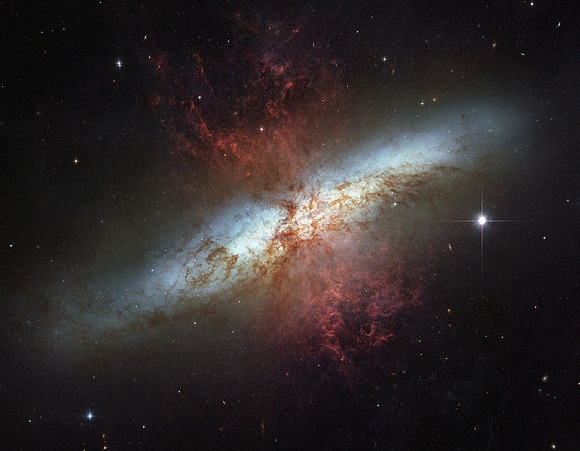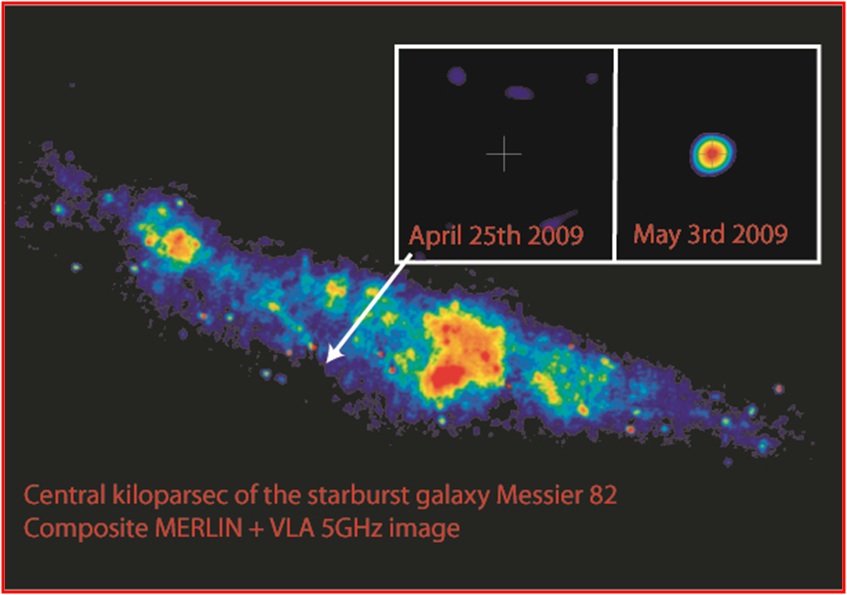The galaxy M82 is located 12 million light years away in the nearby M81 galaxy group. It is a spiral galaxy that has a diameter of about 40,000 light years and is being viewed nearly edge on, its plane being oriented at about 10° to our line of sight. It is described as a “peculiar galaxy” or “starburst galaxy” because for its small size it is very energetic, being five times more luminous than the entire Milky Way or 100 times more luminous than the Milky Way’s central region which is of comparable size. In my opinion, M82 is a galaxy whose supermassive core was active in the recent past and whose energetic activity is due to one or more superwaves that are in the process of propagating through its disc. Currently, M82’s supermassive core has entered its quiescent phase and has shut off its energetic emission, which is why it is not visible to either X-ray telescope or radio telescope investigations. If we had such telescopes in operation 80 years ago, we likely would have detected M82’s core and seen that it was quite luminous.
The accepted explanation for M82’s energetic activity is that it is due to the galaxy’s interaction with its neighbor, M81, which lies 150,000 light years (four galaxy diameters) away. However, the notion that M82 would be collisional interaction with M81 is preposterous, the two galaxies being so far apart that they are in no direct contact with one another. Moreover this conventional explanation fails to account for the fact that M81 appears as a perfectly normal spiral galaxy, certainly not what one would expect if the two were energetically interacting.
In 2009 a strange phenomenon was observed in M82. In their April 15, 2010 news posting, the Royal Astronomical Society reported that radio astronomers at the University of Manchester’s Jodrell Bank Observatory had discovered a strange new energetic source in M82. It appeared very suddenly in radio wavelengths and showed no signs of going away. According to Dr. Muxlow: “The new object, which appeared in May 2009, has left us scratching our heads – we’ve never seen anything quite like this before, the object turned on very rapidly within a few days and shows no sign of decaying in brightness.”
In their Monthly Notices paper, Muxlow, et al. (2010) report the peculiar finding that during that year they observed the source to be progressively moving in an east-to west direction at 4.2c (4.2 times the speed of light). They realized that this could not be radio emission from a supernova shell since supernova shells have not been observed to expand at speeds greater than ~7.5% c. One alternative that the group has considered is that this superluminal radio source is a highly relativistic volley of cosmic rays approaching us and beaming their radiation in our direction. They wanted to interpret it as being cosmic ray radio emission from a ‘micro-quasar’, but found this alternative inadequate because they could find no associated source of X-ray emission.
But, similar polarized radio sources have been seen to separate from active galactic cores at superluminal speeds, and astronomers have interpreted these as being synchrotron radiation emission generated by cosmic rays traveling towards us and beaming their radiation in our direction, a phenomenon termed relativistic beaming. In my 1983 Ph.D. dissertation I interpreted such apparent superluminal motion as evidence of a superwave moving out from the active nucleus as a shell of cosmic ray radiation. In places where this radiation shell interacts with magnetic fields or remnants in the galaxy it will generate synchrotron radiation and beam it outward in a narrow cone that we happen to see since the cone is oriented in our direction. Due to the fact that the cosmic rays are coming towards us at close to the speed of light, the emission produced by the interactions that these cosmic rays undergo during their journey towards us will be time-compressed and will give the appearance that the emission source in the distant galaxy is moving transverse to our line of site at speeds faster than that of light.
So here in M82 we have one more example of cosmic rays traveling rectilinearly through the galaxy at a near light speed velocity. This is precisely what the superwave theory has claimed for more than 30 years. In the case of M82, where the source has been observed to move in an east to west direction at 4.2 c, this implies that we are seeing radiation from cosmic ray electrons that have a Lorentz factor of γ = 4.2 that are traveling at 1/4.2 radians, or 13.6°, to our line of sight. A superwave is predicted to travel outward isotropically from its point of origin as an expanding shell. But because of this relativistic beaming effect, we are only able to see the radiation produced by a small part of this shell, the part that is moving in our direction and beaming radiation towards us.
This is basically a simple concept and yet astrophysicists persist in making the ad hoc positivist assumption that the cosmic rays are confined to a linear beam (like that coming from a subrelativistic particle-beam weapon). They recognize the existence only of those cosmic rays that happen to be producing the radiation we are seeing. Any other’s don’t really exist for them. Unfortunately, their overly restrictive, frontal-lobotomy interpretation seriously distorts the real situation. Secondly, in other cases where they might not see any superluminal motion, they immediately alter their model to assume that the radio emission comes from a narrow jet of incoherently radiating magnetized plasma which is oriented almost perpendicular to our line of sight. Hence they assume the emission to be produced by cosmic rays that are traveling at subluminal velocities and for the most part are not even coming towards us but are chaotically scrambled in all directions within the beam! Whether or not the radio sources exhibit superluminal or subliminal movement, it does not take too much savy to realize that both cases represent emission being radiated towards us from a superwave shell formed of relativistic cosmic rays following radial trajectories, and not from a low velocity cosmic ray plasma jet or bubble (e.g., as they have assumed for the Fermi bubbles in our own Galaxy).
The superluminal source in M82 is found just 20 light years (projected in the plane of the sky) from M82’s dynamical center. So most likely these cosmic rays originated in M82’s unseen supermassive core. Given that the emission we are seeing is coming from cosmic rays that are beaming their radiation at an angle of 1/4.2 radians to our line of sight, then these relativistic electrons have likely travelled 80 light years away from the core, towards us, from the time their volley was first launched. The counterintuitive finding that the superluminal motion is east-to-west, hence towards the core could be produced if these relativistic particles were encountering a magnetic plasma barrier that was transversely oriented and positioned closer to the core on its eastern side than its western side. So it is possible that the superluminal radio source originated from M82’s supermassive core about 80 years ago and that thereafter the core went into its quiescent state. In this case there is no reason to postulate the existence of a separate unseen ‘micro-quasar’.
Maxlow, et al. (2010) have discounted the active galactic nucleus explanation for these cosmic rays on the grounds that this radio source is displaced from the Galaxy’s dynamical center (e.g., by 20 light years in projection). But this point of view fails to realize that cosmic rays can propagate significant distances from a core before producing significant radio emission, as well as the fact that their formerly active core could disappear into a quiescent state.
Another piece of evidence indicating that M82 is dominated by the effects of radially expanding superwaves is the finding that it emanates what astronomers call a “super wind” (note they picked a term very close to superwave). Infrared observations have found a strong wind of dust and gas moving outward at speeds of ~200 km/s and extending outward hundreds of thousands of light years as it ejects material away from M82. For example, see the reddish wispy material in the top image extending from the galaxy’s two poles. Although the superwave cosmic rays travel outward isotropically, it is in the polar directions, above and below the galaxy’s plane, that the interstellar medium is sparsest and offers the least resistance to superwave cosmic rays and their generated wind.
Dr. Gandhi who has studied this super wind reports that it “is found to originate from multiple ejection sites spread over hundreds of light years rather than emanating from any single cluster of new stars.” He says “We can now distinguish ‘pillars’ of fast gas , and even a structure resembling the surface of a ‘bubble’ about 450 light years wide” (DailyGalaxy news report). This is an accurate description of what one would expect from a galactic superwave, one that had expanded hundreds of light years away from its formerly active supermassive core.
Another unusual feature about M82 is its unusually high rate of supernova explosions being seen there. Four supernovae have been seen in M82 over the past three decades with three of these occurring just in the last 10 years. By comparison, only one supernova has been seen over the past hundred years in its neighboring galaxy M81, which has a diameter twice that of M82. So obviously something is happening in M82 that triggers supernovae at a very high rate. That something is the one or more galactic superwaves that are now propagating through its disc and triggering supernovae. How a superwave triggers supernovae through its associated gravity wave and through cosmic dust injection onto a star is discussed in my Ph.D. dissertation. There I also present evidence of how a superwave traveling through our own galactic disc has triggered an unusually large number of supernovae in the Milky Way.
Previously the radio galaxy Centaurus A was considered to be the closest exploding galaxy to the Milky Way (distance 10 – 16 million light years). Now we find that M82 at 12 million light years rivals for this position. Just because its core is not luminous does not mean that it is not undergoing significant core explosion activity. The radio lobes which have recently appeared in the polar ring galaxy NGC 660 also appear to show evidence of superwave propagation.


